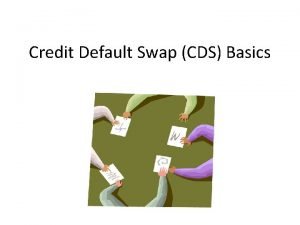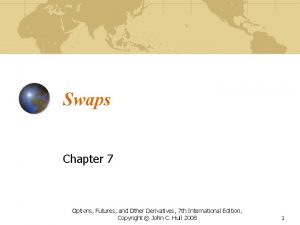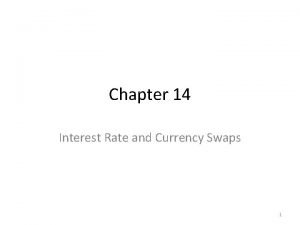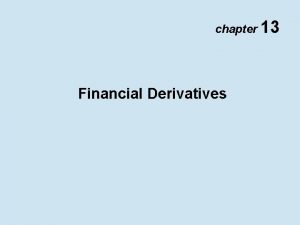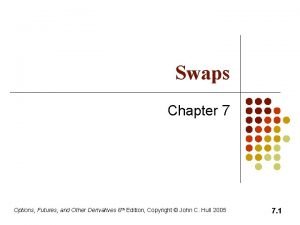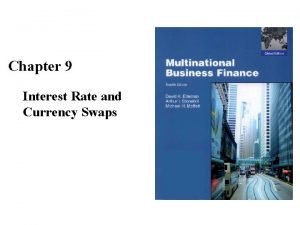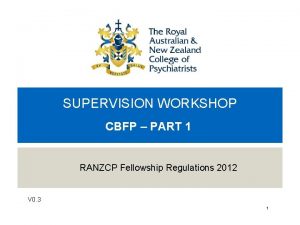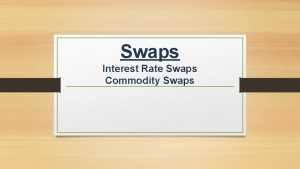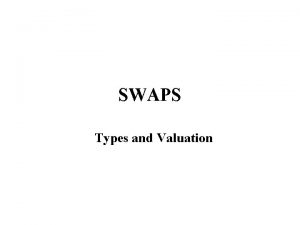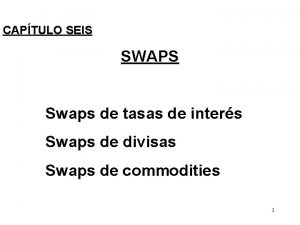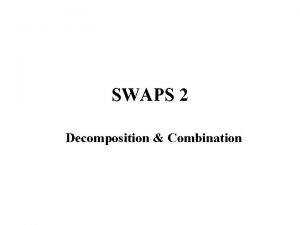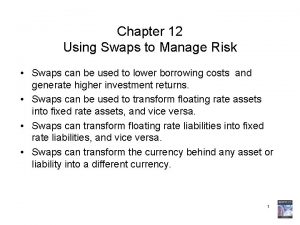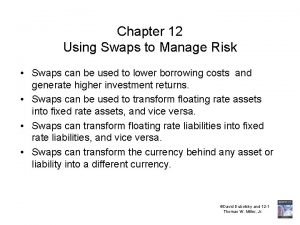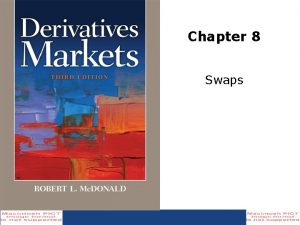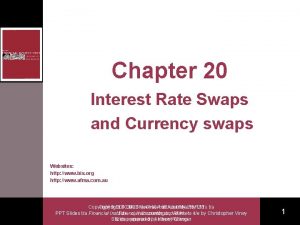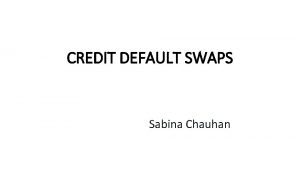24 th India Fellowship Seminar Use of swaps





















- Slides: 21

24 th India Fellowship Seminar Use of swaps for hedging reinvestment risks in regular premium non-participating products Guide Name: Jose John 10 th December, 2015 Presenter Names: Sanghamitra Dey Jenil Shah Pratik Agarwal Indian Actuarial Profession Serving the Cause of Public Interest

Agenda Section Page 1 Background 4 2 Tools to mitigate Reinvestment risks 10 4 Interest rate Swaps 11 6 Regulations with regard to Swaps 14 7 Summary 20

1. Background üNon par regular premium product üReinvestment risk

Background Regular premium non par product ► For a non‐par (non-linked) product, insurance company guarantees benefits either on maturity or death of the insured ► The policyholder do not participate in the profits of the company ► The insurer bears all the investment risk and hence requires higher risk premium than par product where investment risk is shared ► Regular premium brings in additional reinvestment risk www. actuariesindia. org 4

Background Re-investment Risk ► Re-investment risk is the risk that the proceeds from premiums and coupons received, are reinvested at a lower rate than assumed in the pricing basis ► ► Significant re-investment risk in regular premium non par: ► Future premiums and coupons investment return uncertain ► No sharing of profits If the benefit payout is linked to floating interest rate rather than fixed interest rate, this risk will be lower www. actuariesindia. org 5

Product Investment Cycle Returns are guaranteed First and renewal premium. (Source of reinvestment risk) Initiation of the contract Receipt of Premium Monitoring and rebalancing portfolio Monitoring Benefit payments www. actuariesindia. org Pooled premiums are invested Investmen t Investment cycle Hedging Market Risk ALM Derivatives like Swaps and others 6

Interest Rate Outlook - India Interest Rate Market Outlook ► Based on various media houses and brokerage reports, interest rates are expected to decline ► Under such circumstances, reinvest risk becomes a major risk for the Indian insurance market ► The investment team along with the actuarial team will need to take steps based on their investment appetite www. actuariesindia. org

Apr_2011 Jun_2011 Aug_2011 Oct_2011 Dec_2011 Feb_2012 Apr_2012 Jun_2012 Aug_2012 Oct_2012 Dec_2012 Feb_2013 Apr_2013 Jun_2013 Aug_2013 Oct_2013 Dec_2013 Feb_2014 Apr_2014 Jun_2014 Aug_2014 Oct_2014 Dec_2014 Feb_2015 Apr_2015 Jun_2015 Aug_2015 Oct_2015 Repo Rate Interest Rate History- India Interest Rate 9 8. 5 8 7. 5 7 6. 5 6 5. 5 5 Source: Database on Indian Economy RBI www. actuariesindia. org

Tools for managing re-investment risk in non par products 9

Tools to manage re-investment risk Merits & Demerits of each approach Risk Transfer – Financial Derivatives ► Pros ► ► ► ► ► Higher Risk Higher Economic Capital requirement Risk Avoidance Economies of Scale & Lesser portfolio rebalancing Better returns Pros ► ► ► Products’ cash-flow pattern may differ De-growth in NB and lower persistency Risk due to different experience among products No Cost of Hedging Less portfolio rebalancing Cons ► ► Substituting market risk with credit risk Expensive & requires continuous monitoring Pros: ► ► ► Risk retention- Portfolio Approach ► Pros: Reduces risk and stabilize returns Reduces Economic capital requirements Cons ► ► Risk retention- No hedge Lesser investment risk Lesser economic capital requirement Cons ► ► Non Par business tend to be more profitable Less diversification of product portfolio Another risk reduction strategy could be developing non par products where benefit payout is linked to floating rate financial instrument or an index. (For e. g. G-Sec). www. actuariesindia. org

Financial Derivative Interest Rate Swap ► Agreement – Exchange floating rate for fixed rate at specified nominal specified time ► An IRS will have four basic features: • The term or tenor • The notional amount • The frequency • Swap rate: Fixed rate component of the swap & is quoted in the market ► The asset liability mismatch can be avoided ► Customized and OTC instrument ► Being an OTC instrument IRS tends to reduce basis risk www. actuariesindia. org

IRS – How it works IRS and the re-investment risk embedded in non par products ► Insurers can enter into interest rate swap contract ► Premiums/coupons would be invested and the floating rate obtained could be exchanged for fixed rate as per the product guarantee ► Insurance companies can be protected against downside in the interest rates by locking into the fixed leg of the swaps www. actuariesindia. org

Comparison Interest Swaps vs Interest Rate Future ► Tends to be more expensive than Interest Rate Future ► Not available for longer horizons (10+) ► Lower Liquidity & Higher Credit Risk ► Limited availability in India (Only few large banks), whereas IRF are exchange traded. ► Limited knowledge to operate once entered into a contract www. actuariesindia. org

Regulation – Financial derivatives

Regulations and Practice Standards– Brief Overview Regulation/Standards Description Dealing in financial derivatives Section 11 (IRDA – Investment Regulations 2000) Dealing in Financial derivatives is permitted in accordance with the guidelines issued by the Authority from time to time ALSM (Asset Liability and Solvency Margin Regulations ) 2000 In relation to interest rates, specifies the considerations for setting of valuation interest rate Circular (11 th June 2014)– Guidelines on Interest rate derivatives Guidelines to deal with interest rate derivatives Actuarial Practice Standards 2 Additional guidance to set valuation parameters, with primary reference to ALSM regulation s 2000 Actuarial Practice Standards 7 Guidance to determining margins of adverse deviation Accounting Standards 30 Recognition and measurement of Derivatives Accounting Standards 31 and 32 Presentation and Disclosure requirements www. actuariesindia. org

Regulation (1) – Dealing in Financial Derivative Guidelines • Plain vanilla interest rate swaps , interest rate future and forward rate agreements (mostly sold over the counter) in rupee are permitted • IRS having explicit/implicit option are prohibited • Used for hedging purposes only. Company must demonstrate this • Counterparties and exposure to counterparties (limits, method) are specified • Restriction on total exposure specified (notional principal amount equivalent to 100% of the book value of the fixed income investments of the Participant under the policyholder’s fund (excluding ULIP ) and shareholders’ fund taken together) www. actuariesindia. org

Regulation (2) - Dealing in Financial Derivative Guidelines • Dealings in interest rate derivative are in general governed by guidelines issued by RBI and also be complaint with SEBI guidelines • Pre-approved risk management policy by the board of directors • Board ensure the suitability and appropriateness of the investment • Efficient corporate governance, where the board and the insurer know the complex products and the risks involved • Reporting as per IRDAI guidelines and documentation requirements as per RBI and ISDA guidelines, accounting standards as per AS 30 www. actuariesindia. org

ALSM Regulations 2000 - Valuation Interest Rate (1) IRDA ALSM Regulations 2000 Prudent valuation rate for liability valuation • Prudent assessment of yields • Composition of assets (including derivatives if any) supporting liabilities • Future investment conditions • Reinvestment strategy • Risk of decline in rates www. actuariesindia. org

APS - Valuation Interest Rate Actuarial Practice Standards 2 • References to the ALSM regulations on interest rate assumptions Actuarial Practice Standards 7 Minimum Margin for prudent valuation : • Immediate rise or fall, from the current best estimate assumption, of 10%of the current gross redemption yield on 10 - year gilts for the next five years. Thereafter, a rise or fall of a further 10% of current yields, whichever is more adverse for the office. • Considerations in deciding the margin to account for interest rate risk: ► Securing policyholder’s interest ► Consider all options to the policyholders (specially ones detrimental to shareholder’s and other policyholders) ► Relevant experience www. actuariesindia. org

Summary Regular premium non par product ► Interest rate movements tends to increase the re-investment risk for Non par product ► Interest rate swap and other interest rate derivatives help in reducing this risk ► Detailed analysis need to be carried before choosing the appropriate strategy for managing risk www. actuariesindia. org 20

24 th India Fellowship Seminar Contact us: sangha 85@gmail. com pratiknagarwal@gmail. com jenil 10@yahoo. com Indian Actuarial Profession Serving the Cause of Public Interest
 Short position meaning
Short position meaning Credit default swap ppt
Credit default swap ppt Selling credit default swaps
Selling credit default swaps Interst rate swaps
Interst rate swaps Banker swaps rat race for bus lane
Banker swaps rat race for bus lane Mercados de forwards y swaps
Mercados de forwards y swaps Swapsmuy
Swapsmuy Advantages of interest rate swaps
Advantages of interest rate swaps Unwinding swaps
Unwinding swaps Advantages and disadvantages of derivatives
Advantages and disadvantages of derivatives Swaps example
Swaps example Considering interestrate swaps, the swap rate is
Considering interestrate swaps, the swap rate is Seminar on education in india
Seminar on education in india Xenos christian fellowship
Xenos christian fellowship Durer melancholia magic square
Durer melancholia magic square Unc hematology oncology fellowship
Unc hematology oncology fellowship Ranzcp wba
Ranzcp wba Rutgers pharmacy fellowship
Rutgers pharmacy fellowship Richmond fellowship trust
Richmond fellowship trust Grace fellowship manchester
Grace fellowship manchester Full gospel businessmen fellowship ghana
Full gospel businessmen fellowship ghana Full gospel businessmen
Full gospel businessmen


